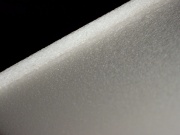Difference between revisions of "Foamed solids, generic"
(username removed) |
(username removed) |
||
| Line 2: | Line 2: | ||
== Description == | == Description == | ||
| − | Polymers containing uniformly dispersed air pockets. All foamed plastics are lightweight and buoyant. Additionally they may be soft and spongy (foam rubber, polyethylene, etc.) or rigid and strong (polystyrene, epoxy). Steam, air, or an inert gas is mechanically added or chemically produced in the plastic resins during manufacture to form a cured open cellular structure. Closed-cell foams have individual non-connected bubbles while open-cell foams have an interconnected tunnels formed when the incorporated gas or steam escapes during cure. Foamed plastics are made from most types of polymers ([http://cameo.mfa.org/materials/fullrecord.asp?name=foam | + | Polymers containing uniformly dispersed air pockets. All foamed plastics are lightweight and buoyant. Additionally they may be soft and spongy (foam rubber, polyethylene, etc.) or rigid and strong (polystyrene, epoxy). Steam, air, or an inert gas is mechanically added or chemically produced in the plastic resins during manufacture to form a cured open cellular structure. Closed-cell foams have individual non-connected bubbles while open-cell foams have an interconnected tunnels formed when the incorporated gas or steam escapes during cure. Foamed plastics are made from most types of polymers ([http://cameo.mfa.org/materials/fullrecord.asp?name=foam%20rubber foam rubber], [http://cameo.mfa.org/materials/fullrecord.asp?name=polyethylene polyethylene], [http://cameo.mfa.org/materials/fullrecord.asp?name=polystyrene polystyrene], [http://cameo.mfa.org/materials/fullrecord.asp?name=epoxy epoxy], [http://cameo.mfa.org/materials/fullrecord.asp?name=polyurethane polyurethane], [http://cameo.mfa.org/materials/fullrecord.asp?name=vinyl%20resin vinyl resins], [http://cameo.mfa.org/materials/fullrecord.asp?name=silicone%20resin silicone resins], etc.) |
[[File:closedcellpolyfoam2.jpg|thumb|Closed cell polyethylene foam]] | [[File:closedcellpolyfoam2.jpg|thumb|Closed cell polyethylene foam]] | ||
== Synonyms and Related Terms == | == Synonyms and Related Terms == | ||
| − | goma espuma (Esp.); plastique | + | goma espuma (Esp.); plastique expensé (Fr.); mousse de plastique (Fr.); plastic foam (AAT preferred); foam rubber; expanded plastic; cellular plastic; Styrofoam; |
== Hazards and Safety == | == Hazards and Safety == | ||
| Line 15: | Line 15: | ||
== Authority == | == Authority == | ||
| − | * | + | * Theodore J. Reinhart, 'Glossary of Terms', ''Engineered Plastics'', ASM International, 1988 |
| − | * | + | * Richard S. Lewis, ''Hawley's Condensed Chemical Dictionary'', Van Nostrand Reinhold, New York, 10th ed., 1993 |
| − | * | + | * Pam Hatchfield, ''Pollutants in the Museum Environment'', Archetype Press, London, 2002 |
* ''Van Nostrand's Scientific Encyclopedia'', Douglas M. Considine (ed.), Van Nostrand Reinhold, New York, 1976 | * ''Van Nostrand's Scientific Encyclopedia'', Douglas M. Considine (ed.), Van Nostrand Reinhold, New York, 1976 | ||
Revision as of 06:53, 24 July 2013
Description
Polymers containing uniformly dispersed air pockets. All foamed plastics are lightweight and buoyant. Additionally they may be soft and spongy (foam rubber, polyethylene, etc.) or rigid and strong (polystyrene, epoxy). Steam, air, or an inert gas is mechanically added or chemically produced in the plastic resins during manufacture to form a cured open cellular structure. Closed-cell foams have individual non-connected bubbles while open-cell foams have an interconnected tunnels formed when the incorporated gas or steam escapes during cure. Foamed plastics are made from most types of polymers (foam rubber, polyethylene, polystyrene, epoxy, polyurethane, vinyl resins, silicone resins, etc.)
Synonyms and Related Terms
goma espuma (Esp.); plastique expensé (Fr.); mousse de plastique (Fr.); plastic foam (AAT preferred); foam rubber; expanded plastic; cellular plastic; Styrofoam;
Hazards and Safety
Most are combustible.
Authority
- Theodore J. Reinhart, 'Glossary of Terms', Engineered Plastics, ASM International, 1988
- Richard S. Lewis, Hawley's Condensed Chemical Dictionary, Van Nostrand Reinhold, New York, 10th ed., 1993
- Pam Hatchfield, Pollutants in the Museum Environment, Archetype Press, London, 2002
- Van Nostrand's Scientific Encyclopedia, Douglas M. Considine (ed.), Van Nostrand Reinhold, New York, 1976
- Art and Architecture Thesaurus Online, http://www.getty.edu/research/tools/vocabulary/aat/, J. Paul Getty Trust, Los Angeles, 2000 Comment: plastic foam (preferred)

